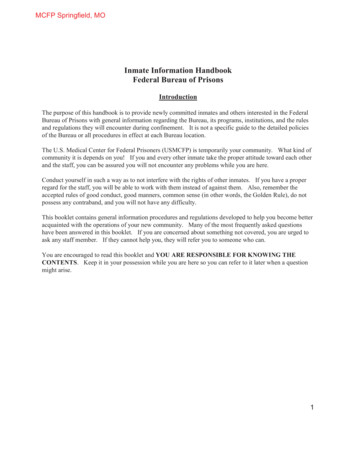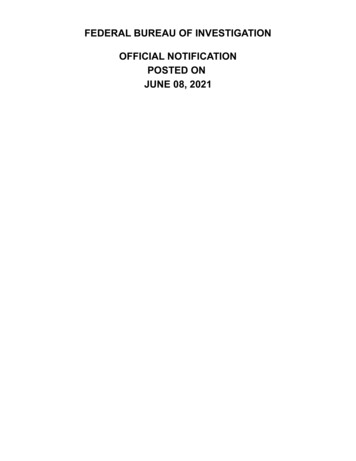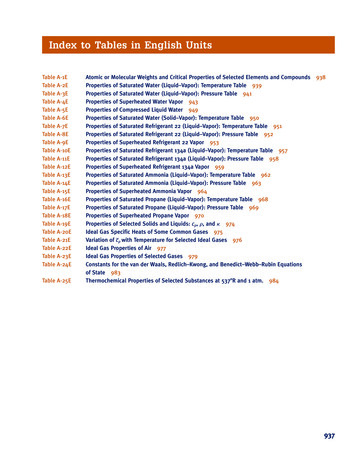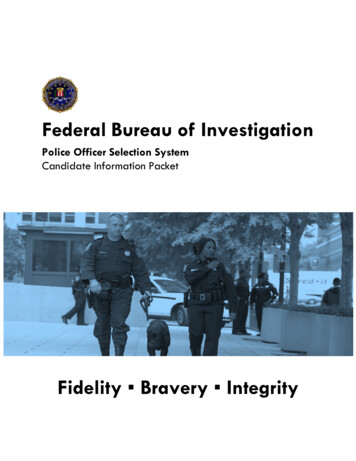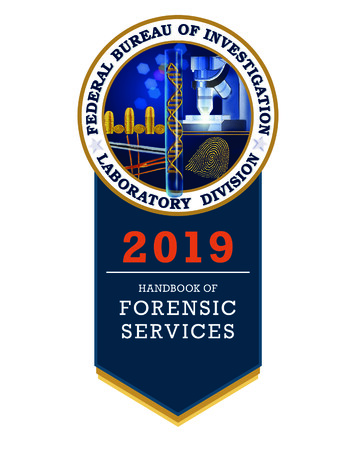
Transcription
INTRODUCTION. . . . . . . . . . . . . . . . . . . . . . . . . . . . . . . . 6FBI Forensic Services. . . . . . . . . . . . . . . . . . . . . . . . . . . . . 6Additional Case Acceptance Guidelines. . . . . . . . . . . . . . . 7SUBMITTING EVIDENCE. . . . . . . . . . . . . . . . . . . . . . . . . . 9Requesting Evidence Examinations. . . . . . . . . . . . . . . . . . 9Packaging and Shipping Evidence. . . . . . . . . . . . . . . . . . 11EVIDENCE EXAMINATIONS AND SERVICES. . . . . . . . . . 13CRIME SCENE SAFETY . . . . . . . . . . . . . . . . . . . . . . . . . 92Routes of Exposure. . . . . . . . . . . . . . . . . . . . . . . . . . . . . 92Safety . . . . . . . . . . . . . . . . . . . . . . . . . . . . . . . . . . . . . . . 93Personal Protective Equipment . . . . . . . . . . . . . . . . . . . 99Hazardous Materials Transportation . . . . . . . . . . . . . . . 101Hazardous Waste Regulations . . . . . . . . . . . . . . . . . . . . 101References . . . . . . . . . . . . . . . . . . . . . . . . . . . . . . . . . . . 103INDEX. . . . . . . . . . . . . . . . . . . . . . . . . . . . . . . . . . . . . . . . 1054HANDBOOK OF FORENSIC SERVICES 2019TABLE OF CONTENTS
The Handbook of Forensic Services provides guidance andprocedures for safe and efficient methods of collecting, preserving,packaging, and shipping evidence and describes the forensicexaminations performed by the FBI’s Laboratory Division.FBI FORENSIC SERVICESThe successful investigation and prosecution of crimes require, in most cases, thecollection, preservation, and forensic analysis of evidence. Forensic analysis ofevidence is often crucial to determinations of guilt or innocence.The FBI has one of the largest and most comprehensive forensic laboratories in theworld, and the FBI Laboratory is accredited by the ANSI National Accreditation Board(ANAB). The forensic services of the FBI Laboratory Division are available to thefollowing: FBI field offices and legal attachés; U.S. attorneys, military tribunals, and other federal agencies for civil and criminalmatters; and State, county, and municipal law enforcement agencies in the United States andterritorial possessions for criminal matters.All forensic services, including expert witness testimonies, are rendered free of cost;however, the following limitations apply: No examination will be conducted on evidence that has been previously subjectedto the same type of examination. Exceptions may be granted when there arereasons for a reexamination. These reasons should be explained in separateletters from the director of the laboratory that conducted the original examination,the prosecuting attorney, and the investigating agency. Exceptions require theapproval of the Laboratory Director or a designee. NOTE: Please see Explosivesand Hazardous Devices Examinations Section for further exemptions. No request for an examination will be accepted from laboratories havingthe capability of conducting the examination. Exceptions may be grantedupon approval of the FBI Laboratory Director or a designee. NOTE: Please6HANDBOOK OF FORENSIC SERVICES 2019INTRODUCTION
HANDBOOK OF FORENSIC SERVICES 2019see Explosives and Hazardous Device Examinations Section for furtherexemptions. No testimony will be furnished if testimony on the same subject and in the samecase is provided for the prosecution by another expert. No request for an examination will be accepted from a nonfederal law enforcementagency in civil matters. No requests will be accepted from private individuals or agencies.In addition, when submitting evidence to the FBI Laboratory, contributors acknowledgethe following: FBI examiners will choose appropriate technical processes to address thecontributor’s request for examination, including additional testing as initial testingresults warrant. Depending on the caseload of the Laboratory and the needs of the contributor,evidence examinations may be subcontracted at FBI expense. An FBI Laboratory Report may contain the opinions and/or interpretations of theexaminer(s) who issued the report. A simplified FBI Laboratory Report will be prepared to improve the contributer'sability to read the report. Information not included in the report will be retainedin the FBI Laboratory. A list of information omitted from the Laboratory Report isavailable upon requestADDITIONAL CASE ACCEPTANCE GUIDELINESThe FBI accepts evidence related to all crimes under investigation by FBI field offices;however, it accepts from other federal, state, and local law enforcement agencies onlyevidence related to violent crime investigations. The FBI does not routinely acceptevidence from state and local law enforcement agencies in cases involving propertycrimes unless there was personal injury or intent to cause personal injury. Theseguidelines help to ensure that the FBI continues to provide timely forensic assistanceto law enforcement agencies investigating crimes of violence or threatened violence.Additional restrictions may be imposed on case acceptance to achieve this goal.At the discretion of the FBI Laboratory Director or a designee, the FBI may acceptevidence from property crime cases. Such exceptions will be considered on a caseby-case basis and should not be regarded as setting a precedent for future case7
The following are examples of property crimes that are not routinely accepted forexaminations: Arson of unoccupied residential and commercial buildings and property (unlessterrorism, such as an environmental terrorist attack, is suspected). Explosive incidents and hoaxes targeting unoccupied residential and commercialbuildings and property (unless terrorism, such as an environmental terrorist attack,is suspected). Vandalism and malicious mischief directed toward residential or commercialbuildings and property. Nonfatal traffic accidents involving headlight examinations except in cases involvinglaw enforcement and government officials. Hit-and-run automobile accidents not involving personal injury. Automobile theft, except automobile theft rings or carjackings. Breaking and entering. Burglary. Minor theft (under 100,000). Minor fraud (under 100,000).8HANDBOOK OF FORENSIC SERVICES 2019acceptance. All accepted cases will be afforded the full range of forensic servicesprovided by the FBI.
HANDBOOK OF FORENSIC SERVICES 2019SUBMITTING EVIDENCEREQUESTING EVIDENCE EXAMINATIONSAll requests for evidence examinations should be in writing, on agency letterhead, andaddressed to the FBI Laboratory Evidence Management Program, unless otherwiseindicated in the Examinations section.NOTE: TEDAC evidence submissions will be accepted with an accompanying TEDACEvidence Submission Form. The TEDAC Evidence Submission form is a fillable PDFand specifies the required information for evidence submissions to TEDAC. Copies ofthis form are available on the Explosive Reference Tool Site (EXPERT), TEDAC EvidenceManagement Unit (EMU) FBINET site, or by contacting TEDAC EMU at 256-213-2360.Do not submit multiple cases under a single communication. Each case should besubmitted with a separate communication and packaged separately. NOTE: Pleasesee Explosives and Hazardous Devices Examinations Section for exemptions tothis practice.All international law enforcement agency/police requests should be coordinatedthrough the appropriate FBI legal attaché (LEGAT). LEGATs should coordinatewith the Evidence Management Unit, prior to submitting any evidence to theLaboratory. Questions concerning international submissions should be directed to703-632-8360.Requests for evidence examinations must contain the following information: The submitting contact person’s name, agency, address, and telephone number; Previous case-identification numbers, evidence submissions, and communicationsrelating to the case; Description of the nature and the basic facts of the case as they pertain toevidence examinations; The name(s) of and descriptive data about the individual(s) involved (subject,suspect, victim, or a combination of those categories) and the agency-assigned,case-identification number; The violation; Reason for expedited examination, if requested;9
The name of the relevant prosecutor’s office or prosecutor assigned, if available; What type(s) of examination(s) is/are requested; Where the evidence should be returned and where the Laboratory report should besent (a street address and phone number must be included); and A statement if there is local controversy or if other law enforcement agencies havean interest in the case. Please see Explosives and Hazardous Devices Examinations Section for guidanceon IED evidence retention and submission documentation.10HANDBOOK OF FORENSIC SERVICES 2019 A list of the evidence being submitted and a copy of the letter should be includedin all containers in which evidence has been shipped to the Laboratory. The lettershould be in a seperate envelope within the shipping container.
HANDBOOK OF FORENSIC SERVICES 2019PACKAGING AND SHIPPING EVIDENCEUnless otherwise indicated in a specific Examination section, follow the belowguidelines for packaging and shipping evidence. Please keep in mind the FBI caseacceptance guidelines and limitations in the Introduction section. Prior to packaging and shipping evidence, call the pertinent unit or the EvidenceManagement Unit for specific instructions. Take precautions to preserve the evidence. Wrap and seal each item of evidence separately to avoid contamination. Place the evidence in a clean, dry, and previously unused inner container. Seal the inner container with tamper-evident or filament tape. Affix BIOHAZARD labels, if appropriate, on the inner container. If any of theevidence needs to be examined for latent prints, affix a label on the inner container. A copy of the evidence examination request should be submitted with eachshipping container and it should be contained in a seperate envelope from allevidence. Place the sealed inner container in a clean and dry outer container with cleanpacking materials. Do not use loose Styrofoam. Completely seal the outer container so that tampering with the container would beevident. All shipments of suspected or confirmed hazardous materials must complywith U.S. Department of Transportation and International Air Transport Associationregulations. Title 49 of the Code of Federal Regulations (CFR) lists specificrequirements that must be observed when preparing hazardous materials forshipment by air, land, or sea. In addition, the International Air Transport Associationannually publishes Dangerous Goods Regulations detailing how to prepare andpackage shipments for air transportation. Title 49 CFR 172.101 provides a Hazardous Materials Table that identifies itemsconsidered hazardous for the purpose of transportation. Title 49 CFR 172.101also addresses special provisions for certain materials, hazardous materialscommunications, emergency response information, and training requirements forshippers. A trained and qualified evidence technician must assist with the typing,labeling, packaging, and shipping of all hazardous materials.11
U.S. Department of Transportation regulations and the following guidelines must befollowed when shipping live ammunition: Package and ship ammunition separately from firearm(s). The outside of the container must be labeled “ORM-D, CARTRIDGES, SMALLARMS.” The Declaration of Dangerous Goods must include the number of packages andthe gross weight in grams of the completed packages.Unless otherwise indicated in the Examinations section, address the outer container asfollows:EVIDENCE MANAGEMENT UNITLABORATORY DIVISIONFEDERAL BUREAU OF INVESTIGATION2501 INVESTIGATION PARKWAYQUANTICO VA 22135Ship evidence by trackable means such as U.S. Postal Service Registered Mail, UPS,or FedEx.12HANDBOOK OF FORENSIC SERVICES 2019 Further information regarding shipping of Hazardous Materials or potentialChemical/Biological/Radiological/Nuclear (CBRN) Material can be found inWMD/CBRN Evidence Examinations.
HANDBOOK OF FORENSIC SERVICES 2019EVIDENCE EXAMINATIONSAND SERVICESWhen submitting evidence for any of the following examinations andservices, follow all instructions in the Introduction and SubmittingEvidence sections of this Handbook in addition to any specificinstructions provided in the examination and service descriptions.ADHESIVE, CAULK, AND SEALANTEXAMINATIONS15CRIME SCENE SURVEYS, DOCUMENTATION,AND RECONSTRUCTION26ADVANCED PHOTOGRAPHY 15CRYPTANALYSIS EXAMINATIONSAGE OF DOCUMENT EXAMINATIONS16DEMONSTRATIVE EVIDENCE 27ANTHROPOLOGICAL EXAMINATIONS16DNA CASEWORK EXAMINATIONSARSON EXAMINATIONS17BANK ROBBERY NOTE FILE18BIOLOGICAL MATERIAL EXAMINATIONS19BUILDING MATERIALS EXAMINATIONS2020BULLET JACKET ALLOY EXAMINATIONS21BURNED OR CHARRED PAPEREXAMINATIONS 2236DRUG RESIDUE EXAMINATIONS36EMBOSSING AND SEALS EXAMINATIONS 36EVIDENCE RESPONSE TEAM 37EXPLOSIVES & HAZARDOUS DEVICESEXAMINATIONS38FABRIC EXAMINATIONSCARBON PAPER OR CARBON-FILM RIBBONEXAMINATIONS22CARTRIDGE CASE AND SHOTSHELL CASING(FIRED) EXAMINATIONS23CARTRIDGE/SHOTSHELL AND AMMUNITIONCOMPONENT (UNFIRED) EXAMINATIONS 24CONTROLLED SUBSTANCEEXAMINATIONS25DRUG RECORDS EXAMINATIONSEXPLOSIVES CHEMISTRY EXAMINATIONS 41CARBON-14 EXAMINATIONS 22CHECKWRITERS EXAMINATIONS27DOCUMENT ALTERATIONS AND AUTHENTICITYEXAMS 34BANK SECURITY DEVICE EXAMINATIONS 19BULLET EXAMINATIONS262442FBI DISASTER VICTIM IDENTIFICATION42FEDERAL DNA DATABASE (FORMERLY FEDERALCONVICTED OFFENDER) EXAMINATIONS 43FIBER EXAMINATIONS46FIREARMS EXAMINATIONS 46FIREARMS IMAGE EXAMINATIONS 47FIRE DEBRIS ANALYSIS47FOOTWEAR AND TIRE EXAMINATIONS1348
PAPER RECONSTRUCTIONGAMBLING DEVICE EXAMINATIONS 54PEPPER SPRAY EXAMINATIONSGAMBLING RECORDS EXAMINATIONS54PHARMACEUTICAL EXAMINATIONSGIS MAPPING AND AERIAL PHOTOGRAPHY 54GLASS EXAMINATIONS755577PHOTOCOPY OR FACSIMILEEXAMINATIONS77PHOTO PROCESSINGGRAPHIC ARTS (COMMERCIAL AND OFFICEPRINTING) EXAMINATIONS 567678PLASTIC BAG EXAMINATIONS78HAIR EXAMINATIONS 57POLYMER EXAMINATIONSHANDWRITING AND HAND PRINTINGEXAMINATIONS58POST-MORTEM FORENSIC FACIAL IMAGING79HUMAN SMUGGLING RECORDSEXAMINATIONS59PRODUCT TAMPERING EXAMINATIONSINK EXAMINATIONS 59KNOWN HANDWRITING INSTRUCTIONS6066808181SERIAL NUMBER (ALTERED)EXAMINATIONS82SOIL EXAMINATIONS 83SPECIAL EVENT AND SITUATIONALAWARENESS SUPPORT8466METALLURGY EXAMINATIONSRADIOACTIVE MATERIALS EXAMINATIONSSAFE INSULATION EXAMINATIONSLIQUID SOAKED DOCUMENT PRESERVATION 65LUBRICANT EXAMINATIONS80RUBBER STAMP EXAMINATIONSLATENT PRINT (FRICTION RIDGE)EXAMINATIONS6167MUZZLE-TO-TARGET DISTANCEDETERMINATION69SYMBOL EXAMINATIONS84TAPE EXAMINATIONS84NATIONAL DNA INDEX SYSTEM/COMBINED DNAINDEX SYSTEM70THREATENING COMMUNICATIONDATABASE 85NATIONAL INTEGRATED BALLISTICINFORMATION NETWORK (NIBIN) 70TOOLMARK EXAMINATIONSTOXICOLOGY EXAMINATIONS87NATIONAL MISSING PERSON DNA DATABASE(NMPDD) PROGRAM 71TYPEWRITING EXAMINATIONS89PACKAGING EXAMINATIONSPAINT EXAMINATIONS74PAPER EXAMINATIONS757380PROSTITUTION RECORDS EXAMINATIONSROPE OR CORDAGE EXAMINATIONS 81LABORATORY SHOOTING RECONSTRUCTIONTEAM 61LOAN RECORDS EXAMINATIONS7986UNKNOWNS (GENERAL CHEMICAL)EXAMINATIONS90WEAPONS OF MASS DESTRUCTION/CBRNEXAMINATIONS9114HANDBOOK OF FORENSIC SERVICES 2019FORENSIC FACIAL IMAGING 53
HANDBOOK OF FORENSIC SERVICES 2019Adhesive, Caulk, and Sealant ExaminationsAdhesives, caulks, and sealants can be compared by color and chemical compositionwith suspected sources. The source and manufacturer of adhesives, caulks, andsealants cannot be determined by compositional analysis.Questions concerning adhesive, caulk, and sealant evidence should be directedto 703-632-8441.Collection and packaging considerations: When possible, submit the item to which the adhesive, caulk, or sealant isadhered. If this is not possible, remove a sample of the material with a clean, sharpinstrument and transfer it to a resealable plastic bag or leakproof container such asa screw top vial or plastic pill box. Submit a suspected source. Package separately.Advanced PhotographyHighly skilled Scientific & Technical Photographers can provide detailed and accurateon-site documentation using oblique and vertical aerial photography (also see GISMapping and Aerial Photography), 360-degree spherical photography, 360-degreespherical video, and high-resolution imagery for special operations, crime scenes, andspecial events. All photographs can be georeferenced, allowing imagery to be usedby Visual Information Specialists to prepare crime scene diagrams, digitally interactivescenes, and scenario reconstructions (also see Demonstrative Evidence and SpecialEvent and Situational Awareness Support).Questions concerning advanced photography can be directed to your FieldPhotographer or be directed to 703-632-8194.15
The earliest date a document could have been prepared may be determined byexamining various physical characteristics, including watermarks, indented writing,printing, typewriting, and inks.Questions concerning age of document examinations should be directed to 703632-8444.Collection and packaging considerations: Documentary evidence must be preserved in the condition in which it was found.It must not be unnecessarily folded, torn, marked, soiled, stamped, or written on orhandled excessively. Protect the evidence from inadvertent indented writing. Mark documents unobtrusively by writing the collector’s initials, date, and otherinformation in pencil. Whenever possible, submit the original evidence. The lack of detail in photocopiesmakes examinations difficult and often will result in inconclusive opinions.Anthropological ExaminationsAnthropological examinations involve the analysis of skeletal remains (or potentialskeletal remains). Examinations can result in the determination, interpretation, orestimation of: Whether material is skeletal (bone or tooth) versus some other material. Whether bones are human or non-human. Whether more than one individual is represented. Whether bones are modern or ancient. Biological information from certain bones (such as age, sex, ancestry, stature). Skeletal trauma type and timing (such as projectile, blunt, or sharp force trauma). Personal identification by comparison to known samples (such as medical records). Facial approximations, which are facilitated in conjunction with forensic imagingartists.16HANDBOOK OF FORENSIC SERVICES 2019Age of Document Examinations
HANDBOOK OF FORENSIC SERVICES 2019Forensic anthropologists are also available to assist in the detection and recovery ofremains.Questions concerning anthropological examinations should be directed to 703632-8449.Case acceptance is based in part on the condition of the material; for cases withsignificant soft tissue remaining, please call 703-632-8449 for guidance prior tosubmission. In some cases, the determination of whether bones are human or nonhuman can be determined from submitted images (either by mail or by email). Tosubmit images for analysis, please call 703-632-8449 for guidance.Collection and packaging considerations: Collect bones (or small bone assemblages) individually in paper bags or otherbreathable material. Tin foil may be formed around burned or very fragile bones. Sealed, plastic packaging may be acceptable for remains with fresh/wet tissue. As needed, include cold packs and/or ‘Biohazard’ stickers. Minimize contact between bones and movement within the shipping container. If in doubt, please call for assistance.Arson ExaminationsArson examinations can determine the presence of ignitable liquids introduced to a firescene. Examinations of debris recovered from scenes can identify gasoline, fuel oils,and specialty solvents. Examinations generally cannot identify specific brands.Questions concerning arson examinations should be directed to 703-632-8441.Collection and packaging considerations: Search questioned arson scenes for candles, cigarettes, matchbooks, Molotovcocktails, fused chemical masses, or any electronic or mechanical devices anarsonist may have used.17
Ignitable liquids are volatile and easily lost through evaporation. Preserve evidencein airtight containers such as metal cans, glass jars, or heat-sealed plastic bagsapproved for fire debris. Do not fill containers to the top. Leave at least threeinches of space between the evidence and top of the container. Pack to preventbreakage.Bank Robbery Note FileThe Bank Robbery Note File (BRNF) contains images of notes used in bank robberies.This file can be searched in an attempt to associate text from one bank robbery notewith text from bank robbery notes in other cases. Digital submissions of demandnotes for BRNF searches are accepted. FBI offices can attach the image(s) to theirElectronic Communication/Lead Report via Sentinel. State and local law enforcementcan submit the image(s) along with their request communication on agency letterheadto bankrobberysearch@ic.fbi.gov.Questions concerning the BRNF should be directed to 703-632-8444.Collection and packaging considerations: Documentary evidence must be preserved in the condition in which it was found.It must not be unnecessarily folded, torn, marked, soiled, stamped, or written on orhandled excessively. Protect the evidence from inadvertent indented writing. Mark documents unobtrusively by writing the collector’s initials, date, and otherinformation in pencil. Whenever possible, submit the original evidence; however, photocopies aresufficient for reference file searches.18HANDBOOK OF FORENSIC SERVICES 2019 Search for burn trails on cloth or paper, burn trails on carpeted or hardwood floors,and the removal of personal property or commercial inventory.
HANDBOOK OF FORENSIC SERVICES 2019Bank Security Device ExaminationsBank security devices contain dye to stain money and clothing, while some alsocontain tear gas to disorient a robber. Items such as money and clothing can beanalyzed for the presence of bank security dye and tear gas.Questions concerning bank security device evidence should be directed to 703632-8441.Collection and packaging considerations: Only evidence with visible red or pink stains will be examined. Do not submit large stained evidence (e.g., car seats). When possible, cut a smallsample of the stained area and submit in a heat-sealed or resealable plastic bag. When cutting is not possible, transfer questioned stains by rubbing with a clean(dry or wet with alcohol) cotton swab. Provide an unused swab as a control. Airdry the swab and pack separately from control swab in heat-sealed or resealableplastic bags.Biological Material ExaminationsThe FBI Laboratory can provide expertise for conducting examinations on a variety ofbiological samples and related bioinformatic data. These examinations can assist indetermination of such things as speciation, identification, relatedness, and designedgenetic modifications. These examinations are conducted at FBI-designated partnerlaboratories. Examples of biological materials that can be examined include: Pathogenic microbes (including select agents). Non-pathogenic microbes. Animals. Plants. Insects. Biological toxins. Genetically modified organisms.19
Synthetically produced organisms or biological materials.Building Materials ExaminationsExaminations can compare building materials such as brick, mortar, plaster, stucco,cement, and concrete.Questions concerning building materials evidence should be directed to 703632-8449.Collection and packaging considerations: When building materials are penetrated or damaged, debris can adhere to people,clothing, tools, bags, and stolen items and can transfer to vehicles. If possible,submit the evidence to the Laboratory for examiners to remove the debris. Packageeach item in a separate leakproof container. Do not process tools for latent prints. Collect known samples from the penetrated or damaged areas. Ship known and questioned debris separately to avoid contamination. Submitknown and questioned debris in leakproof containers such as film canisters orplastic pill bottles. Do not use paper or glass containers. Pack to keep lumps intact.Bullet ExaminationsA fired bullet can be examined to determine physical characteristics, including weight,caliber, bullet design, and general rifling characteristics (GRCs). GRCs are the number,width, and direction of twist of the rifling grooves imparted on a fired bullet by the barrelof a firearm. A microscopic examination of the bullet is conducted to determine if anymarks of value are present.If a suspect firearm is submitted, a direct microscopic comparison is done betweentest-fired bullets and the submitted questioned bullet.If a suspect firearm is not submitted, the submitted fired bullets are intercompared todetermine if they were fired from the same barrel. Using the GRC measurements, asearch of the FBI Laboratory’s GRC database will be conducted to produce a list offirearms that could have fired the bullet(s).20HANDBOOK OF FORENSIC SERVICES 2019Questions regarding biological materials examinations should be directed to 703632-7726. Call 703-632-7726 prior to submitting evidence.
HANDBOOK OF FORENSIC SERVICES 2019Questions concerning bullet examinations should be directed to 703-632-8442.Collection and packaging considerations: Package bullets to prevent contact with other bullets. Bullets can be sent via Registered Mail through the U.S. Postal Service. Evidencemust be packaged separately and identified by date, time, location, collector’sname, case number, and evidence number. Do not mark bullets or other firearm-related evidence. The date, time, location,collector’s name, case number, and evidence number must be on the container. Follow the U.S. Department of Transportation regulations if shipping liveammunition as listed in the Submitting Evidence section.Bullet Jacket Alloy ExaminationsMetal alloy classification can often differentiate among the bullet jacket alloys usedby manufacturers to produce different varieties of bullets. As such, it can be used toexclude a bullet fragment as having originated from a particular type of ammunition.This analysis is most often helpful when attempting to determine which of a group ofshooters may have fired a particular round at a crime scene when the fragment is toomutilated for direct comparison to a firearm.Questions concerning bullet jacket alloy examinations should be directed to 703632-8441.Collection and packaging considerations: Ammunition components such as bullets and cartridge cases can be sent via RegisteredMail through the U.S. Postal Service. Evidence must be packaged separately andidentified by date, time, location, collector’s name, case number, and evidence number. Do not mark bullets, cartridges, or cartridge cases. The date, time, location, collector’sname, case number, and evidence number must be on the container. Follow the U.S. Department of Transportation regulations if shipping liveammunition as listed in the Submitting Evidence section.21
Burned or charred documents (not completely reduced to ash) may be deciphered andstabilized.Questions concerning burned or charred paper examinations should be directedto 703-632-8444.Collection and packaging considerations: The document must be shipped in the container in which it was burned, inpolyester film encapsulation or between layers of cotton in a rigid container. The document must be handled minimally. Documentary evidence must be preserved in the condition in which it was found.It must not be unnecessarily folded, torn, marked, soiled, stamped, or written on orhandled excessively. Protect the evidence from inadvertent indented writing.Carbon-14 ExaminationsCarbon-14 is a radioactive form of carbon. Produced naturally when cosmic raysinteract with the earth’s atmosphere, carbon-14 is absorbed within all living matter andabsorption stops upon death. Carbon-14 examinations can be used to determine theage of a once-living item (e.g., plant, animal, human). Typically, age dating based oncarbon-14 analysis can produce ages within a 4 year uncertainty for items younger than60 years. These exams are conducted at an FBI-designated partner laboratory.Questions concerning Carbon-14 examinations should be directed to 703-8987186. Call 703-898-7186 prior to submitting evidence.Carbon Paper or Carbon-Film Ribbon ExaminationsUsed carbon paper or a carbon-film ribbon, such as a typewriter or a facsimile ribbon,can be examined to disclose the content of the text.Questions concerning carbon paper or carbon-film ribbon should be directed to703-632-8444.Collection and packaging considerations:22HANDBOOK OF FORENSIC SERVICES 2019Burned or Charred Paper Examinations
HANDBOOK OF FORENSIC SERVICES 2019 Documentary evidence must be preserved in the condition in which it was found.It must not be unnecessarily folded, torn, marked, soiled, stamped, or written on orhandled excessively. Protect the evidence from inadvertent indented writing. Mark documents unobtrusively by writing the collector’s initials, date, and otherinformation in pencil.Cartridge Case and Shotshell Casing (Fired) ExaminationsA fired cartridge case or shotshell casing can be examined to determine physicalcharacteristics, including caliber types or gauge, manufacturer, presence/type/extentof mechanism marks, and other properties. A microscopic examination of the cartridgecase/shotshell casing is conducted to determine if any marks of value are present.If a suspect firearm is submitted, a direct microscopic comparison is done betweenthe test-fired cartridge case/shotshell casing and the questioned cartridge case/shotshell casing.If a suspect firearm is no
FEDERAL BUREAU OF INVESTIGATION 2501 INVESTIGATION PARKWAY QUANTICO VA 22135 Ship evidence by trackable mea

